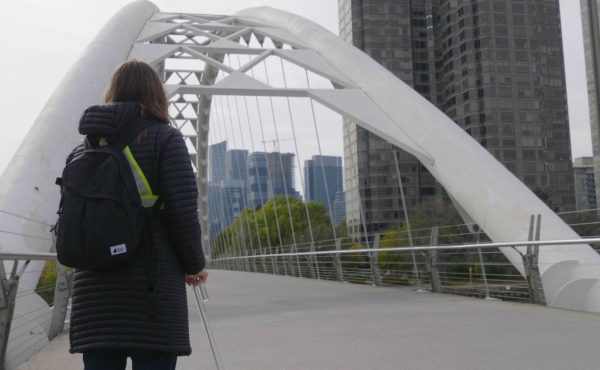
The Networked City
Walk along Yonge Street from Dundas Square to the waterfront and you will hear stories about the neighbourhood, revisit the old Bulova Clock Tower, catch a glimpse of the great outdoors, see text messages translated into Morse code, and learn about the lives of urban pigeons.
The Networked City is a series of five outdoor installations commissioned by InterAccess Electronic Media Arts Centre that highlight the social connections that citizens make on a day-to-day basis by simply travelling from one place to another. These new works are on view from May 26 – June 25, 2006.
More information here.
A Saturday Walk
Walking tours of these interactive outdoor artworks take place on Saturday June 3, from 3 – 5 p.m., with speaker Johanna Householder. She will lead you along Yonge Street, discuss the works and introduce the artists.
Meet at 3 p.m. in Dundas Square near the [murmur] ear by the subway entrance (on the second concrete pillar behind the big TV), or meet at 4 p.m. by the Pigeon Condo at the north-east corner of Yonge and Lakeshore Boulevard.
Afterwards, you are invited back to InterAccess at 9 Ossington Avenue at 6 p.m. for a reception celebrating the launch of The Networked City and also the closing of the Subtle Technologies Festival.
What’s in the networked city?
Toronto collective [murmur] explore the democratic potential of everyday communications media — the cell phone in particular — and ask what happens when such technologies and their uses are made public. In this new work for Yonge-Dundas Square, [murmur] invite response and stories about the square and the neighbourhood.
Germaine Koh uses similar technologies in Relay: Toronto. Participants can send messages via mobile phones which are broadcast in Morse code in a flashing beacon. Viewers and participants can crack the code by watching a monitor that displays the real text of the messages. For more information, see her website. Send a text message to 416 836 5007 to participate. Her work is located at 1 King Street West at Yonge.
The work of Luis Jacob and Amos Latteier incorporates playful interaction to discuss important social issues in Pigeon Condo. Using animal life as a mirror for human social realities, Jacob and Latteier explore urban development and discuss metaphorical housing for pigeons in this area near the railway and the Gardiner Expressway, a site of several condominium developments in progress. Weekend activities consist of pigeon feeding, kite flying, picnics and discussions, while a cell-phone audio tour will inform participants about pigeons and their habitats. This work can be found at the north-east traffic triangle at Yonge and Lakeshore Boulevard.
Paulette Phillips, in her work Bubbalova, recreates the old Bulova clock tower, once a distinctive part of the Toronto cityscape. In Phillips’s version, bubbles flow from the tower, exploring the weightiness of public and collective memory through ephemeral and transitory means on the former site of the Colonial Tavern on Yonge Street between Queen and Dundas, south of Shuter Street.
Marla Hlady has selected the storefront windows of Toronto’s historic Bay department store at the corner of Yonge and Richmond for a site-specific electronic installation. In Wilderness Tourist #3, Hlady explores nature and urban environments through glistening and mesmerizing light effects and soothing sounds.
The Networked City has been made possible with support from the Canada Council for the Arts, the City of Toronto and the University for Peace.


